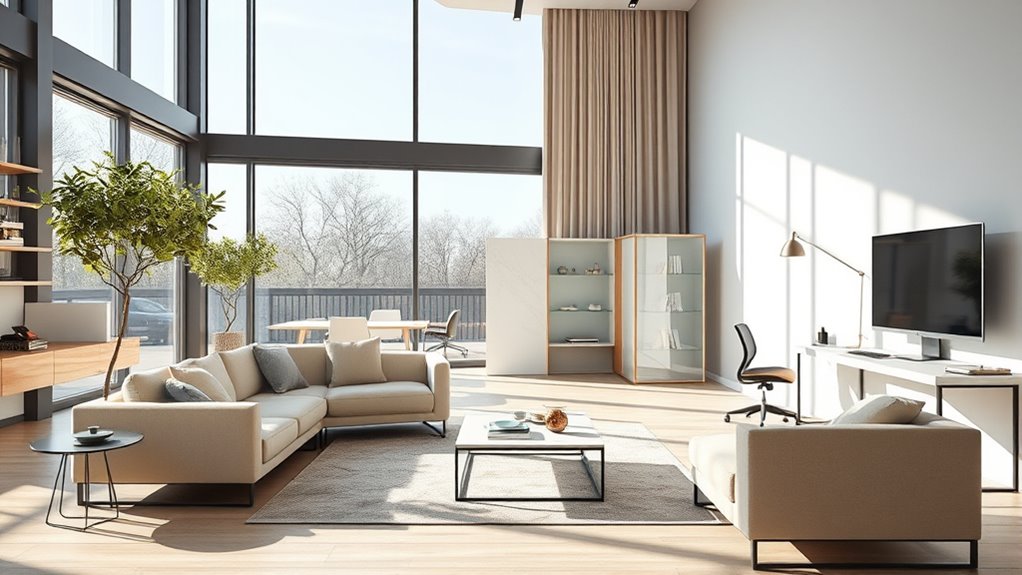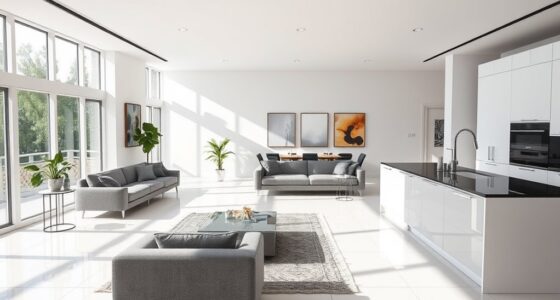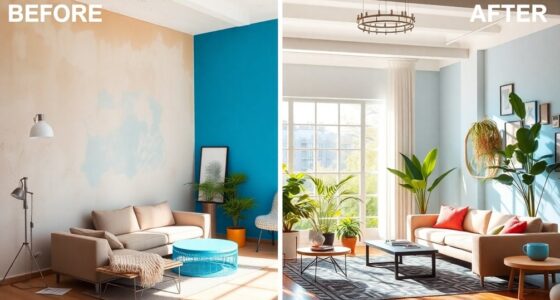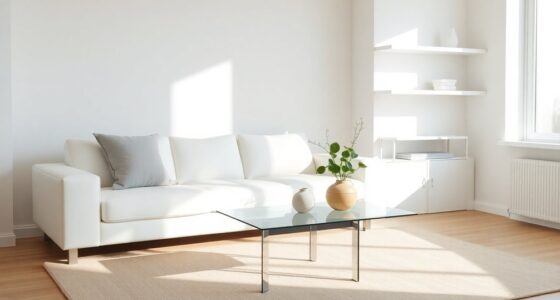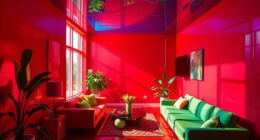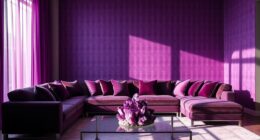Flexible home layouts are reshaping how you use your space by blending multi-functional rooms and smart designs. Open-plan areas, movable walls, and adaptable furniture allow you to quickly transform spaces for work, relaxation, or guests. This approach maximizes every square foot and adapts to your changing needs without major renovations. By incorporating these clever solutions, your home becomes more versatile and enjoyable—if you keep exploring, you’ll discover how to make your space truly work for you.
Key Takeaways
- Flexible home layouts prioritize multi-functional spaces over fixed rooms, maximizing space efficiency and adaptability.
- Open-plan designs, movable walls, and adaptable furniture enable quick transformation of areas for various uses.
- These layouts support remote work, guest hosting, and evolving lifestyle needs without major renovations.
- Smart technology integration allows seamless control and automation of space configurations for convenience.
- They promote smarter space utilization, creating versatile, welcoming environments that grow with users’ changing requirements.

Have you ever wished your home could adapt to your changing needs? Today’s innovative design makes that possible through flexible home layouts that emphasize multi-functional spaces. Instead of traditional rooms with fixed purposes, these layouts promote space optimization, allowing you to transform a single area into multiple functions as your lifestyle evolves. Imagine a living room that can quickly become a home office, a guest bedroom, or a workout zone—all without needing to move furniture around or compromise on space. This versatility is at the heart of modern design, helping you make the most of every square foot.
Flexible home layouts transform one space into multiple functions, adapting to your lifestyle with innovative design.
With the rise of multi-functional spaces, you gain the ability to maximize your home’s potential. Open-plan designs, movable walls, and adaptable furniture are key elements that enable this flexibility. For example, a fold-away bed or a Murphy bed can turn a guest room into a home office in just moments, making space optimization straightforward and efficient. Sliding doors and retractable partitions further enhance this adaptability by allowing you to open up or section off areas as needed. This approach not only saves space but also creates a seamless flow between different zones, making your home feel larger and more welcoming. Incorporating smart technology can also facilitate effortless control over these multifunctional areas, increasing convenience and efficiency.
The beauty of flexible layouts lies in their ability to cater to your lifestyle’s changing demands. If you’re working from home, you can create a dedicated workspace that doesn’t encroach on your leisure areas. When friends or family visit, those same spaces can convert into cozy guest accommodations. As your family grows or your needs shift, your home can evolve without requiring major renovations or additions. This adaptability encourages a smarter use of space, ensuring you’re never stuck with a layout that no longer fits your needs. Additionally, space optimization through clever design choices can help you create dedicated zones for different activities, making your home more versatile and enjoyable.
Furthermore, understanding interior layout principles can assist in designing a home that truly adapts to your lifestyle, blending form and function seamlessly. Advances in smart home technology enable remote control and automation of your space configurations, making the transition between functions even more seamless. Being aware of potential cybersecurity threats and implementing security measures for smart home devices can protect your privacy as these technological integrations become more prevalent. By focusing on space optimization, you’re not just creating a more functional environment—you’re designing a space that grows with you, making everyday living more convenient.
In the end, the rise of multi-functional spaces isn’t just about trendiness; it’s about empowering you to live smarter. Flexible home layouts help you adapt to life’s changes, making your home a true reflection of your needs and style. With innovative design at the core, you can optimize your space without sacrificing comfort or personality, turning your house into a dynamic, adaptable sanctuary.
Frequently Asked Questions
How Do I Choose the Best Multi-Functional Furniture for Small Spaces?
When choosing multi-functional furniture for small spaces, focus on your needs and available space. Look for convertible beds that can easily transform from seating to sleeping areas, saving space. Modular storage options help keep clutter at bay while offering flexibility to adjust as your needs change. Prioritize pieces that are compact, easy to move, and can serve multiple functions, making your small space feel more open and organized.
What Are the Cost Implications of Designing Flexible Home Layouts?
Imagine your home transforming effortlessly—cost implications can be big, but with smart planning, you can keep expenses in check. A thorough cost analysis helps you identify where to splurge or save, ensuring flexible layouts fit your budget. Budget planning becomes your best friend, guiding you through investments in versatile furniture and adaptable spaces without breaking the bank. Flexibility pays off when you balance costs with your dream home vision!
How Can I Maximize Natural Light in Multi-Use Areas?
To maximize natural light in multi-use areas, focus on strategic window placement to make certain sunlight reaches key spaces throughout the day. Incorporate light reflecting surfaces like mirrors or glossy finishes to bounce light around the room. Keep window treatments minimal or sheer to let in more sunlight. By combining thoughtful window placement with reflective elements, you’ll brighten your space and create a more inviting, versatile environment.
Are There Specific Zoning Techniques for Multi-Purpose Rooms?
You can use zoning techniques to effectively divide your multi-purpose rooms. Try furniture placement, such as bookshelves or sofas, to create distinct zones without permanent walls. Area rugs also define spaces and add visual separation. Consider adjustable screens or curtains for flexible space division, allowing you to easily adapt the room for different activities. These zoning techniques enhance functionality while maintaining an open, cohesive feel.
How Do I Maintain Privacy in Open, Flexible Floor Plans?
To maintain privacy in open, flexible floor plans, you can use soundproofing strategies like adding rugs, curtains, or acoustic panels to dampen noise. Privacy screens or movable partitions also work well for creating temporary secluded areas. These solutions allow you to enjoy the benefits of an open layout while ensuring personal space when needed, making your home both functional and private.
Conclusion
As you embrace flexible home layouts, you shape a space that mirrors your life’s rhythm—each room a chapter, each corner a pulse. These adaptable spaces become your sanctuary and your stage, symbolizing freedom and connection. With every move and change, you’re weaving a tapestry of home that flows seamlessly, echoing your evolving needs. In this dance of design, your home is more than a place—it’s a living symbol of growth, resilience, and endless possibility.
